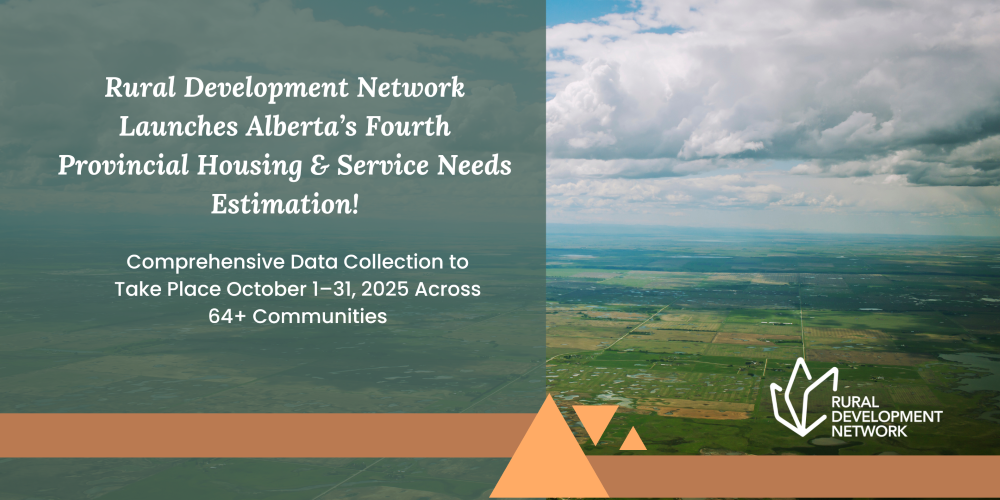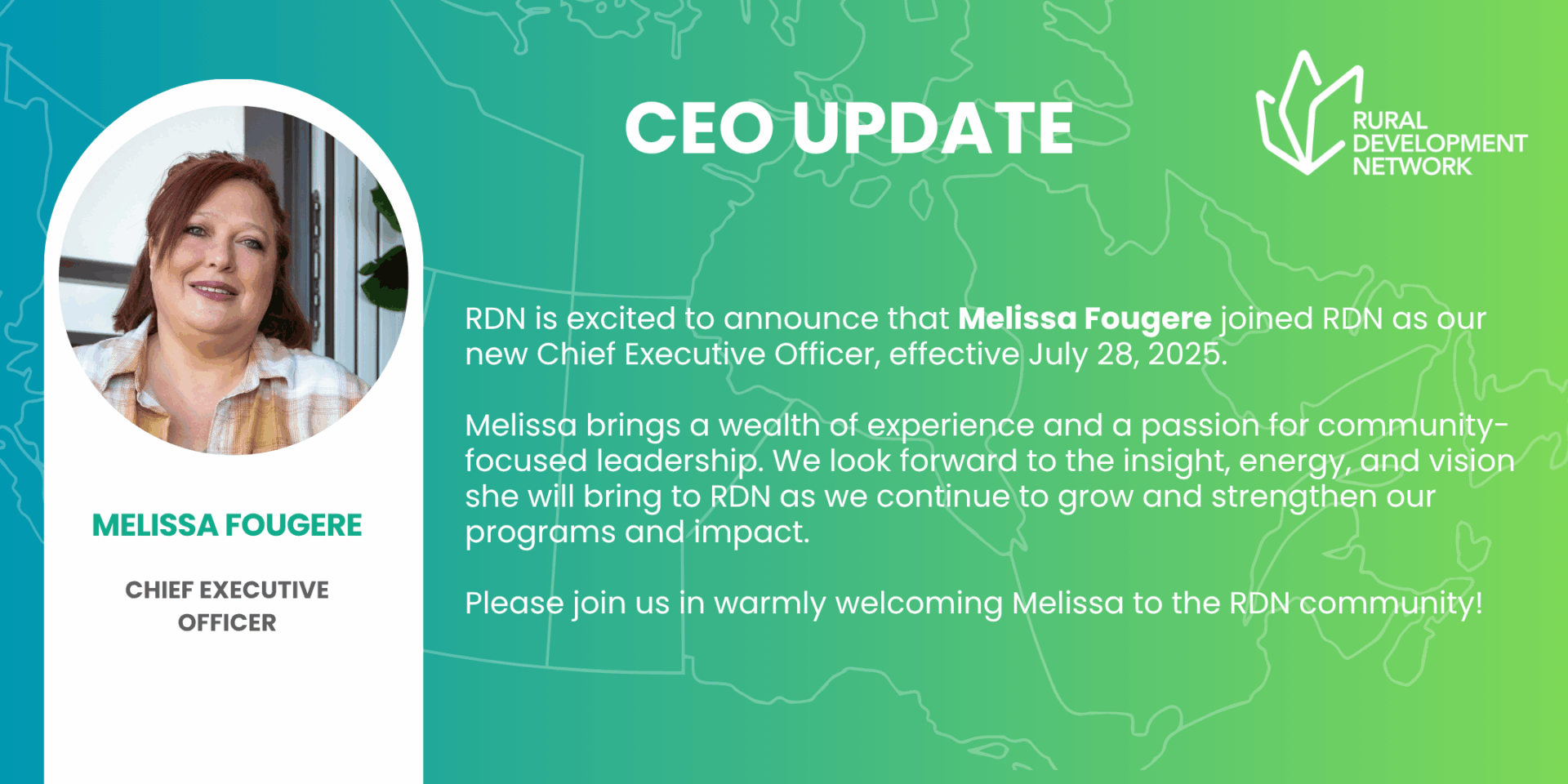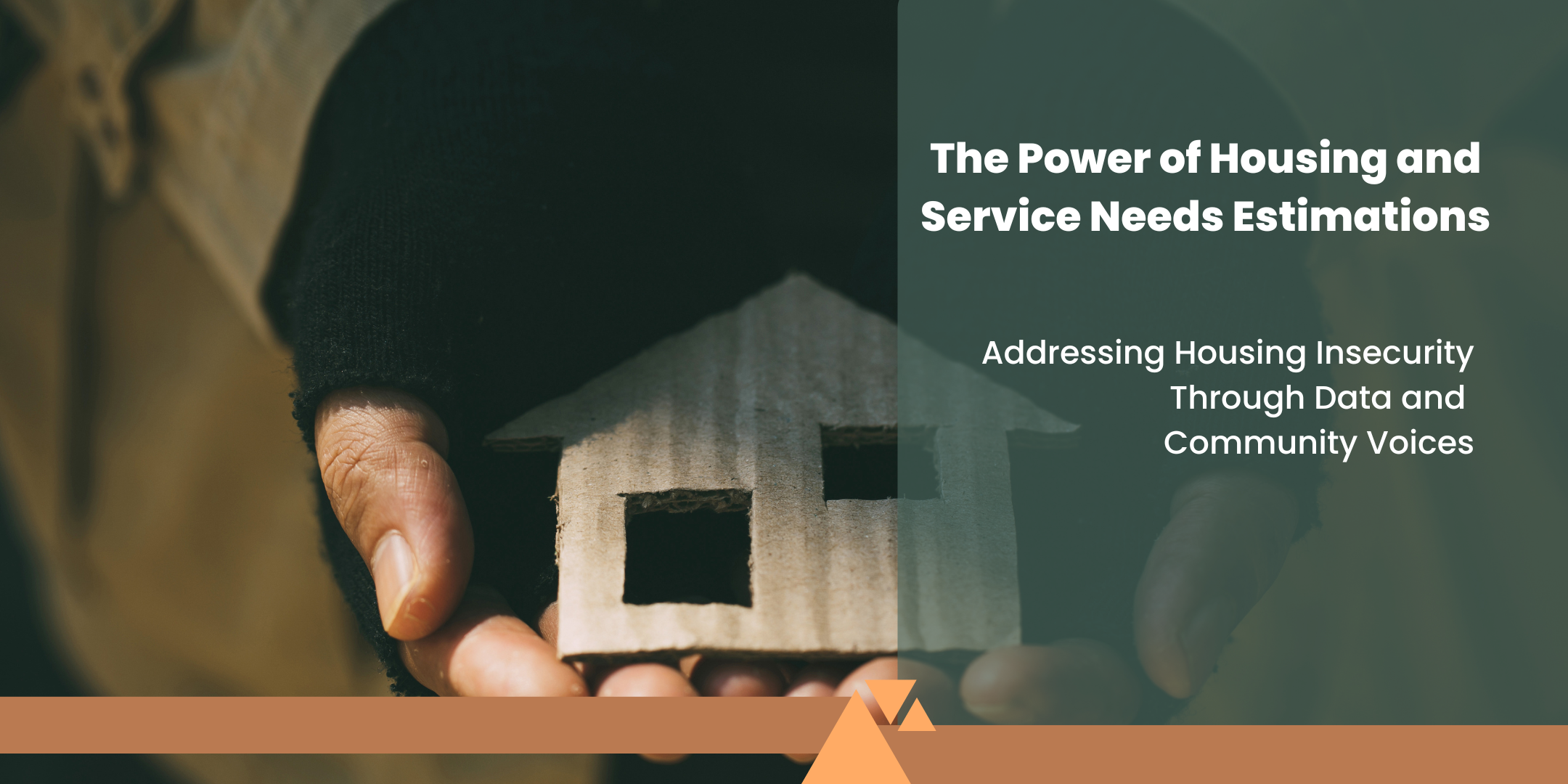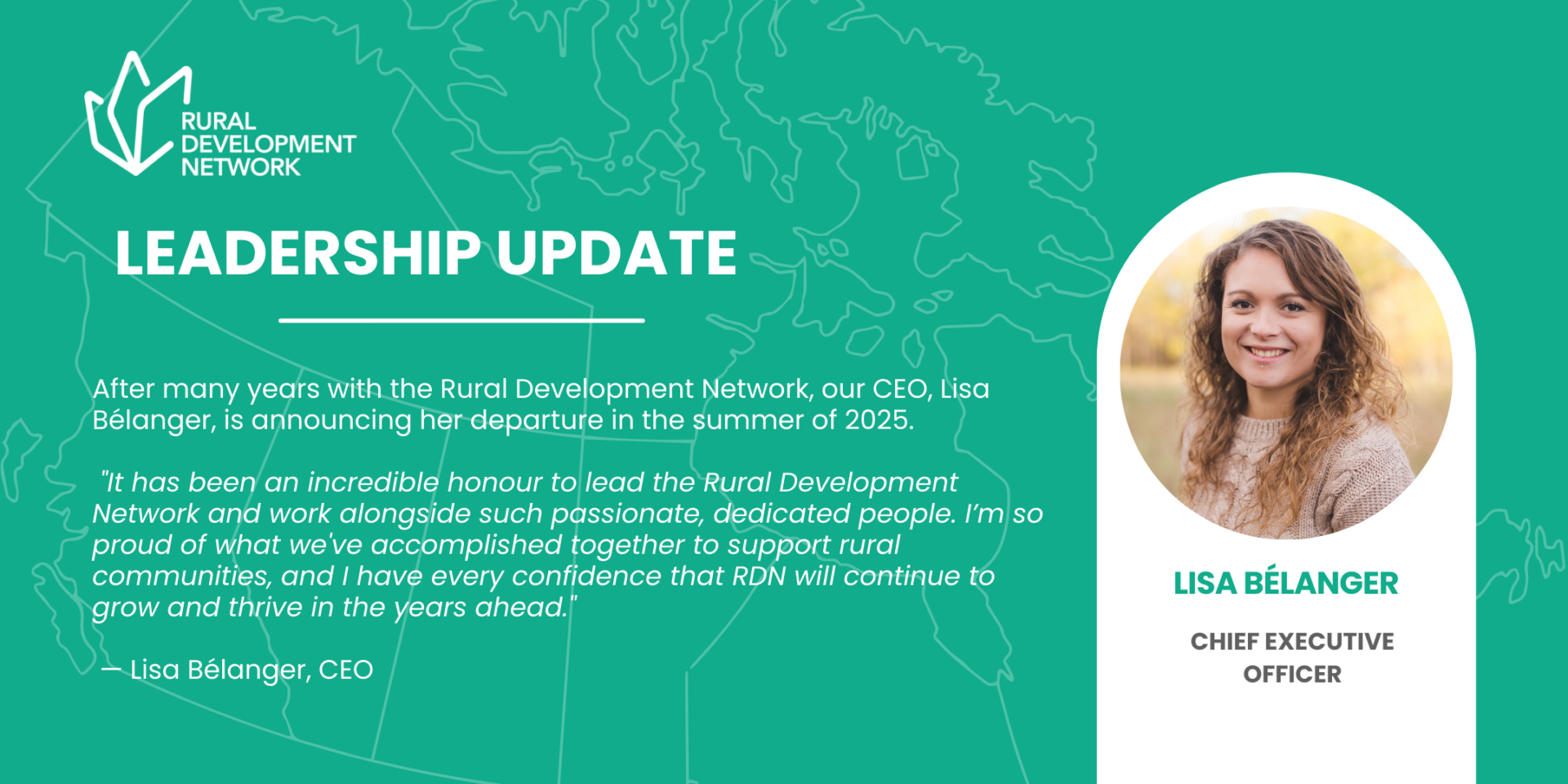
Rural Development Network Launches Alberta’s Fourth Provincial Housing & Service Needs Estimation
 August 12, 2025
August 12, 2025
 Homelessness, News Release
Homelessness, News Release

 August 12, 2025
August 12, 2025
 Homelessness, News Release
Homelessness, News Release
Canada – August 2025

RDN is set to launch its Provincial Housing & Service Needs Estimation this October, a critical initiative aimed at better understanding housing insecurity across the province. From October 1 to 31, 2025, 21 organizations and municipalities representing over 64 rural, remote, and Indigenous communities will participate in collecting localized and regionalized data to build a comprehensive picture of housing insecurity and service needs across the province.
This collaborative effort marks the fourth iteration of the estimation and reflects a continued need for current, accurate, and meaningful data on housing insecurity and service needs in communities and across the province. The process supports the development of responsive, evidence-based solutions tailored to local realities, while also contributing to a broader understanding at the provincial and national levels.
The initiative is funded in part by the Government of Canada’s Reaching Home: Canada’s Homelessness Strategy, a program committed to reducing and preventing homelessness nationwide, the Tenaquip Foundation, and the Catherine Donnelly Foundation.
“By working together across rural, remote, and Indigenous communities, we’re able to capture and highlight the diverse experiences of housing insecurity in Alberta. This data is essential to influencing policy, practices, and funding decisions on housing insecurity while also shaping service provisions in the community,” said Emma Wallace, Program Manager of Community Development and Homelessness Estimations at RDN.
A wrap-up event is planned for Spring 2026, where findings will be shared publicly and used to inform community planning, funding strategies, and policy development at all levels.
Participating Communities Include:
Athabasca, Barrhead, Bow Valley, Camrose, County of Grande Prairie, Drayton Valley, Driftpile Cree Nation, Foothills, Frog Lake First Nation, Hinton, Kneehill County, Lac La Biche, Lloydminster, Peace River, Rocky Mountain House, St. Albert & Sturgeon County, Sundre, Taber, Tri-Region, Westlock, and Whitecourt.
To learn more about the project, please contact the project lead, Emma Wallace, at emmaw@ruraldevelopment.ca
ABOUT THE RURAL DEVELOPMENT NETWORK
We are a non-profit organization that works with rural, remote and Indigenous communities and organizations in Canada. We collaborate to identify and bring focus to rural issues, build local capacity, and develop innovative, rural-based solutions to social and economic challenges.
Media Contacts:
| Melissa Fougere Chief Executive Officer ceo@ruraldevelopment.ca | Joy Vonk Senior Manager, Operations joyv@ruraldevelopment.ca |

TO ALL OF OUR RDN FRIENDS AND COLLEAGUES:
Following an extensive search process, the Board of Directors is pleased to welcome Melissa Fougere as RDN’s Chief Executive Officer as of July 28th, 2025.
Melissa brings over 17 years of nonprofit leadership experience, including senior roles with the Canadian Red Cross, where she led initiatives in emergency management, community resilience, and strategic operations. She holds a Bachelor’s degree in Community Studies from Cape Breton University and a Graduate degree in Disaster & Emergency Management from Royal Roads University. Throughout her career, Melissa has championed collaboration and work with rural, remote, and Indigenous communities, helping build stronger systems, increase local capacity, and drive sustainable development.
The Board is confident that Melissa’s vision, dedication, and experience will be instrumental in her new role.
Melissa succeeds Lisa as RDN’s CEO, and we are grateful for her contributions and commitment to furthering RDN’s mission in supporting rural communities. Her last day will be July 31, 2025.
“I’m incredibly honoured to join RDN at a time when rural communities are facing both immense challenges and big opportunities. Together with this talented team, I’m committed to helping rural communities thrive, adapt, and stay strong in the face of change — because Rural Communities are Stronger Together.” – Melissa Fougere
Please join us in welcoming Melissa to her new role as CEO! We are confident that her leadership will propel RDN forward as we continue to build community capacity in rural, remote, and Indigenous communities across Canada.

When we think about homelessness, we often picture what we see in urban centres, people sleeping rough in parks, shelters, or on busy city streets. This “urban lens” has dominated the national conversation, leading many to believe that homelessness is primarily an urban issue.
But that’s only part of the story.
In rural, remote, and Indigenous communities across Alberta and throughout Canada, homelessness looks very different. It’s often invisible. It’s a family of six crammed into a relative’s two-bedroom home. It’s a young person couchsurfing for months. It’s someone sleeping in their vehicle because there’s no shelter, nowhere else to go, and no one to help. This is the reality of hidden homelessness, and it’s happening at rates equal to or even higher than what we see in cities.
And yet, it remains largely misunderstood, underreported, and unaddressed.
Rural, Remote, and Indigenous communities face unique challenges: limited access to emergency shelters, a lack of affordable housing and public transportation, stretched-thin service providers, and chronic underfunding.
On top of this, there’s a critical lack of reliable, localized data. Without data, rural communities are left out of funding and policy decisions that could bring about real change. They fall through the cracks not because their issues aren’t important, but because those issues aren’t visible.
That’s where the Rural Development Network (RDN) can help.
Driven by community need, RDN developed the Housing and Service Needs Estimation methodology, an approach specifically designed for rural, remote, and Indigenous communities to collect homelessness data.
This survey-based population estimation approach works with local service providers (like libraries, post offices, health centres, food banks, FCSS offices) to gather data over a 30-day period. It’s collaborative, community-driven, and tailored to the realities on the ground. And it’s not just about data, it’s about empowering communities to lead their own responses to housing insecurity.
Since 2018, RDN has supported three successful Alberta Provincial Housing and Service Needs Estimations, most recently in 2023, where they found that 7,320 individuals across 45 rural communities were experiencing housing insecurity. Of those experiencing housing insecurity, 91% were Indigenous.
In preparation for the next Provincial Estimation in Fall 2025, over 25 Alberta communities have already expressed interest in participating. These communities know what’s at stake, and they know that data is the first step toward solutions that work for them.
RDN doesn’t just collect data and leave. They work alongside communities through every stage: from developing localized surveys, to training service providers, to analyzing the results, to supporting advocacy and policy change. The goal? Build long-term capacity so communities can continue this work independently, long after the project ends.
And it’s working. In every case, communities participating in Housing and Service Needs Estimations have seen positive outcomes. Whether securing funding for an emergency shelter program, repurposing an old motel into transitional housing, implementing culturally grounded supportive housing, creating a Housing and Homelessness Task Force, or conducting education and engagement sessions on housing insecurity with community, service providers, and municipal council, communities are using their data to drive meaningful change. This kind of impact is only possible when communities have the tools and information they need to make informed decisions and when they’re supported to take the lead.
The Housing and Service Needs Estimation doesn’t just fill data gaps, it creates a roadmap for systemic change. It gives rural, remote, and Indigenous communities a voice in decisions that affect them. It ensures that policy-makers at all levels of government understand the realities of rural homelessness, so funding and services can be equitably distributed.
RDN’s approach fills that gap; building networks, breaking siloes, and ensuring that people with lived experience of housing insecurity are at the heart of the conversation.
On May 1st, 2025, RDN launched the official Call for Applications for communities to participate in the next Alberta Provincial Housing and Service Needs Estimation, with data collection occurring in October 2025. From beginning to end, the project will span 10 months – 10 months of collaboration, learning, data collection, and action.
And at the end of it, rural, remote, and Indigenous communities will have something they’ve long struggled to access: the evidence they need to advocate for themselves.
Because no one should be invisible. Not in cities. Not in small towns. Not anywhere.

When it comes to housing, one of the most important questions any community can ask is: Are we meeting the needs of our people? A Housing Needs & Demands Assessment (HNA) helps answer that question with clarity and confidence. It’s a powerful planning tool that offers a clear, evidence-based picture of both current housing realities and future requirements.
At the Rural Development Network, we help municipalities, developers, and community leaders uncover what’s really happening in their housing landscape—and what actions will make the biggest difference. It’s important to be proactive to ensure your community is ready to take advantage of opportunities when they arise, funding or otherwise, as they often have short turnaround times to get a project off the ground.
An HNA examines three core areas:
By exploring demographic trends, household income, population growth, bedroom requirements, and housing tenure, the assessment offers a full picture of local housing dynamics.
Effective housing strategies are about more than numbers—they’re about people. That’s why community engagement is a vital part of every HNA we conduct. By listening to residents, local organizations, and community partners, we gain deeper insight into the lived experience behind the data.
Engaging the community helps ensure the housing solutions we recommend are grounded in real-world needs, culturally appropriate, and locally supported. It also builds trust, fosters collaboration, and strengthens the case for funding. Data may also be limited for rural communities, and community engagement allows us to fill in some of the data gaps.
Through surveys and community engagement sessions, we prioritize meaningful participation because the best housing solutions are co-created, not just calculated.
An HNA isn’t just a helpful reference—it’s a strategic necessity. It confirms or challenges assumptions about what a community needs and helps you make informed, confident decisions. It also offers a solid foundation for securing funding and support from government bodies.
Programs such as CMHC’s Affordable Housing Fund and the Federation of Canadian Municipalities’ Sustainable Affordable Housing Green Municipal Fund all require or strongly recommend an HNA as part of funding applications. In short, it’s a must-have if you want to unlock housing opportunities and ensure your plans are grounded in real need.
A complete HNA includes:
Completing a Housing Needs & Demands Assessment can feel overwhelming, but that’s where we come in.
We work alongside communities to gather and analyze data, interpret findings in a meaningful way, and deliver assessments that are clear, actionable, and aligned with funder expectations. Whether you’re starting from scratch or looking to enhance an existing plan, we’ll tailor our support to fit your needs.
From initial consultation to final delivery, we’re your partner in building a stronger, more responsive housing strategy.
If your community is planning housing projects, applying for funding, or simply wants to understand where to focus next—let’s talk.
Together, we can build the foundation for smarter decisions, stronger funding proposals, and more effective housing solutions.

After many years with the Rural Development Network, our CEO, Lisa Bélanger, has announced that she will be moving on from her role. While we’re sad to see her go, we’re incredibly grateful for everything Lisa has poured into RDN over the years. Her leadership, passion, and deep care for rural communities have left a lasting mark on all of us.
Lisa has helped shape RDN into the strong, values-driven organization it is today. Thanks to her vision and the amazing team she’s helped build, we’re in a great position to keep moving forward and growing.
We’re now beginning the search for RDN’s next CEO. If you—or someone you know—would be a great fit, you can find the full job posting here: https://ruraldevelopment.ca/get-involved/careers

For Immediate Release- Feb 19, 2025
ALBERTA — On behalf of the Rural Development Network (RDN), the Sustainable Housing Initiative (SHI) has partnered with Big Lakes County to collaboratively explore locally-informed solutions that will enable diverse housing development in their community.
SHI is working to support diverse, sustainable, and equitable housing development in northern Alberta communities through its Enabling Housing Choice North Project. This project was made possible through funding and support from the Alberta Real Estate Foundation (AREF).
The purpose of this project partnership is to perform extensive research on the challenges and opportunities that currently exist within Big Lakes County’s housing landscape. Findings from this research will assist in responding to the diverse housing demands that emerge from Big Lakes County.
“The Enabling Housing Choice North project is a unique opportunity to respond to the housing challenges facing communities in northern Alberta,” says Lisa Belanger, Chief Executive Officer of the Rural Development Network. “We are excited to work with Big Lakes County to research and identify solutions that promote affordable and diverse housing options. This partnership highlights the importance of local input and collaboration in addressing complex housing needs.”
Big Lakes County is proud to be part of the “Enabling Housing Choice North” Project, part of the Rural Development Network’s Sustainable Housing Initiative” says Reeve, Tyler Airth. “Addressing housing needs is crucial to the well-being of our residents, and this project will help ensure that we can provide diverse, affordable, and sustainable housing options for years to come. As part of Council’s Strategic Plan, we are committed to being a place where people want to live and can afford to live, while also fostering sustainable economic growth. Diverse housing is a key component of this vision. Partnering with RDN and the “Enabling Housing Choice North” Project allows us to invest in a more sustainable future for Big Lakes County.
Project Goals:
About RDN: The Rural Development Network (RDN) is a non-profit organization that works with rural, remote and Indigenous communities and organizations in Canada. We collaborate to identify and bring focus to rural issues, build local capacity, and develop innovative, rural-based solutions to social and economic challenges.
About AREF:: Created through the Real Estate Act, the Alberta Real Estate Foundation is a nonprofit grantmaking organization that supports and strengthens Alberta’s real estate industry and benefits Albertans. Through strategic investments, we fund projects across a diverse range of initiatives designed to bolster the work of the industry, government, and our land and built environments.
Media Contacts:
| Lisa Belanger Chief Executive Officer ceo@ruraldevelopment.ca | Joy Vonk Manager of Operations joyv@ruraldevelopment.ca |

For Immediate Release- Feb 11,2025
ALBERTA — On behalf of the Rural Development Network (RDN), the Sustainable Housing Initiative (SHI) has partnered with Lac Cardinal Country to collaboratively explore locally-informed solutions that will enable diverse housing development in their community.
SHI is working to support diverse, sustainable, and equitable housing development in northern Alberta communities through its Enabling Housing Choice North Project. This project was made possible through funding and support from the Alberta Real Estate Foundation (AREF).
“Recognizing the need to support Municipalities in their effort to accommodate a greater diversity of housing types to meet resident needs, we are pleased to partner with the Rural Development Network and Lac Cardinal Country on this important project” says Patti Morris, Executive Director of the Alberta Real Estate Foundation. “The Enabling Housing Choice North Project aims to drive long-term policy change in Alberta’s rural communities to support long-term resiliency. We are honoured to support this critical effort.”
The purpose of this project partnership is to perform extensive research on the challenges and opportunities that currently exist within Lac Cardinal Country’s housing landscape. Findings from this research will assist in responding to the diverse housing demands that emerge from Lac Cardinal Country.
The Enabling Housing Choice North Project is a pivotal initiative to address the unique housing needs of northern Alberta communities,” says Lisa Belanger, Chief Executive Officer of the Rural Development Network. “We are delighted to work alongside Lac Cardinal Country to identify opportunities for increasing housing diversity and sustainability. By combining research with community collaboration, this partnership will pave the way for locally-informed solutions to meet the region’s evolving housing demands”.
“Lac Cardinal Country is excited to partner with the Rural Development Network allowing us to address the diverse and evolving housing needs of our communities, through the Sustainable Housing Initiative on the Enabling Housing Choice North Project, expressed Dave Allen, Chair of Lac Cardinal Economic Development Board. “This collaboration will ensure that our residents, irrespective of their income or background, have access to safe, affordable, and suitable housing options. This partnership will provide a more targeted approach to tackling issues such as housing shortages, affordability gaps, and the demand for housing that meet the needs of different demographics. When people have access to good housing, it encourages community growth, attracts new residents or businesses, and improves overall quality of life.”
Project Goals:
About RDN: The Rural Development Network (RDN) is a non-profit organization that works with rural, remote and Indigenous communities and organizations in Canada. We collaborate to identify and bring focus to rural issues, build local capacity, and develop innovative, rural-based solutions to social and economic challenges.
About AREF: Created through the Real Estate Act, the Alberta Real Estate Foundation is a nonprofit grantmaking organization that supports and strengthens Alberta’s real estate industry and benefits Albertans. Through strategic investments, we fund projects across a diverse range of initiatives designed to bolster the work of the industry, government, and our land and built environments.
Media Contacts:
| Lisa Belanger Chief Executive Officer ceo@ruraldevelopment.ca | Joy Vonk Manager of Operations joyv@ruraldevelopment.ca |

For Immediate Release- January 24, 2025
ALBERTA — On behalf of the Rural Development Network (RDN), the Sustainable Housing Initiative (SHI) has partnered with the Town of Peace River to collaboratively explore locally-informed solutions that will enable diverse housing development in their community.
SHI is working to support diverse, sustainable, and equitable housing development in northern Alberta communities through its Enabling Housing Choice North Project. This project was made possible through funding and support from the Alberta Real Estate Foundation (AREF).
Recognizing the need to support Municipalities in their effort to accommodate a greater diversity of housing types to meet resident needs, we are pleased to partner with the Rural Development Network and the Town of Peace River on this important project” says Patti Morris, Executive Director of the Alberta Real Estate Foundation. “The Enabling Housing Choice North project aims to drive long-term policy change in Alberta’s rural communities to support long-term resiliency. We are honoured to support this critical effort.
The purpose of this project partnership is to perform extensive research on the challenges and opportunities that currently exist within Peace River’s housing landscape. Findings from this research will assist in responding to the diverse housing demands that emerge from Peace River.
“The Enabling Housing Choice North project is an impactful initiative to help improve housing diversity in northern Alberta communities, benefiting residents and fostering long-term resiliency,” says Lisa Belanger, Chief Executive Officer of the Rural Development Network. “We are excited to work with the Town of Peace River to support the community in developing more housing diversity through research and planning, and to incorporate these strategies into the Guidebook that serves as a resource for communities across the country.”
“We are thrilled to partner with the Rural Development Network and Sustainable Housing Initiative on the Enabling Housing Choice North Project. This is a wonderful opportunity to gain valuable insights into our community’s housing needs and explore innovative ways to meet them.” says Mayor Elaine Manzer of the Town of Peace River.
Project Goals:
About RDN: The Rural Development Network (RDN) is a non-profit organization that works with rural, remote and Indigenous communities and organizations in Canada. We collaborate to identify and bring focus to rural issues, build local capacity, and develop innovative, rural-based solutions to social and economic challenges.
Media Contacts:
| Lisa Belanger Chief Executive Officer ceo@ruraldevelopment.ca | Joy Vonk Manager of Operations joyv@ruraldevelopment.ca |

For Immediate Release- January 20, 2025
ENABLING HOUSING CHOICE NORTH PROJECT IN FAIRVIEW
ALBERTA — On behalf of the Rural Development Network (RDN), the Sustainable Housing Initiative (SHI) has partnered with the Town of Fairview to collaboratively explore locally-informed solutions that will enable diverse housing development in their community.
SHI is working to support diverse, sustainable, and equitable housing development in northern Alberta communities through its Enabling Housing Choice North Project. This project was made possible through funding and support from the Alberta Real Estate Foundation (AREF).
“Recognizing the need to support Municipalities in their effort to accommodate a greater diversity of housing types to meet resident needs, we are pleased to partner with the Rural Development Network and the Town of Fairview on this important project” says Patti Morris, Executive Director of the Alberta Real Estate Foundation. “The Enabling Housing Choice North Project aims to drive long-term policy change in Alberta’s rural communities to support long-term resiliency. We are honoured to support this critical effort.”
The purpose of this project partnership is to perform extensive research on the challenges and opportunities that currently exist within Fairview’s housing landscape. Findings from this research will assist in responding to the diverse housing demands that emerge from Fairview.
“Improving housing choice and diversity is essential to building resilient and thriving communities,” says Lisa Belanger, Chief Executive Officer of the Rural Development Network. “Through the Enabling Housing Choice North project, we are proud to partner with the Town of Fairview to identify effective approaches to meet the housing needs of current and future residents. This collaborative effort will help inform strategies for the community, and be incorporated into the Guidebook as a resource for communities across the country”.
We are thrilled to partner with the Rural Development Network on this project,” says Chair Paul Buck of the Fairview Economic Development Committee. “As our community grows, it is essential that we expand housing options to meet the diverse needs of our residents. This initiative not only supports increased housing choice, but also fosters economic development and long-term growth for Fairview. We are confident that the insights gained from this project will strengthen our community and contribute to a thriving future.
Project Goals:
To identify opportunities for enabling housing choice in Fairview through research and analysis
To understand what housing typology best serves the needs of the community
To increase affordable and diverse housing availability in Fairview
About RDN: The Rural Development Network (RDN) is a non-profit organization that works with rural, remote and Indigenous communities and organizations in Canada. We collaborate to identify and bring focus to rural issues, build local capacity, and develop innovative, rural-based solutions to social and economic challenges.
About AREF: Created through the Real Estate Act, the Alberta Real Estate Foundation is a nonprofit grantmaking organization that supports and strengthens Alberta’s real estate industry and benefits Albertans. Through strategic investments, we fund projects across a diverse range of initiatives designed to bolster the work of the industry, government, and our land and built environments.
Media Contacts:
| Lisa Belanger Chief Executive Officer ceo@ruraldevelopment.ca | Joy Vonk Manager of Operations joyv@ruraldevelopment.ca |
Rayann Campmans, a Grade 12 student from Picture Butte High School, was inspired to create an agricultural program for her school. The program, which aimed to expose students to farm-based learning, gained popularity and drew 56 students this year. The school applied to the creation of the FarmEd Toolkit, Developed by the Rural Development Network, a farm-based learning guide, inspired by a successful school farm project at Altario School in north-central Alberta.
The Altario Agricultural Academy was launched in 2020, and its student-led farm is the hub of numerous learning activities. The farmyard facility houses livestock such as chickens, turkeys, geese, pigs, sheep, and cow-calf pairs. With $300,000 in funds from sources like the Prairie Land Public School Division, the school also recently added a modular, containerized hydroponic operation where students grow leafy greens.
Students in grades one through six act as farmhands, while those in grades seven to 12 assume leadership positions. Their agrarian projects are tied to career studies, and morning chores are followed as needed throughout the day. Students are encouraged to think of farming as a river, with its opposite banks representing educational value and sustainability.
“We really thought there would be opportunity there for other rural schools to implement similar experiential learning initiatives with school farms,” said Lisa Belanger, Rural Development CEO.
Funded by the Sustainable Canadian Agricultural Partnership, Rural Development formed an advisory board and launched a pilot project to create the FarmEd Toolkit. They conducted focus groups with students and staff at Altario and a few other schools that expressed interest in farm programming. Picture Butte High School and Irvine School participated in 2022 as pilot project partners, shaping the final version of the Toolkit.
The FarmEd Toolkit now serves as a guide for communities and schools to invent their own farm-based learning initiatives.